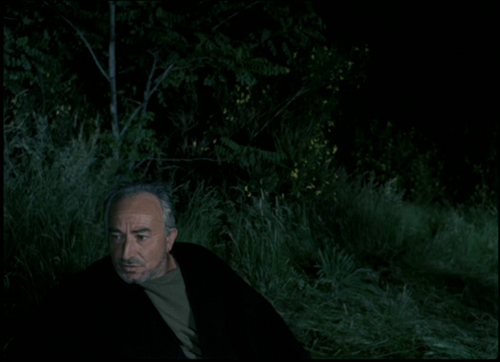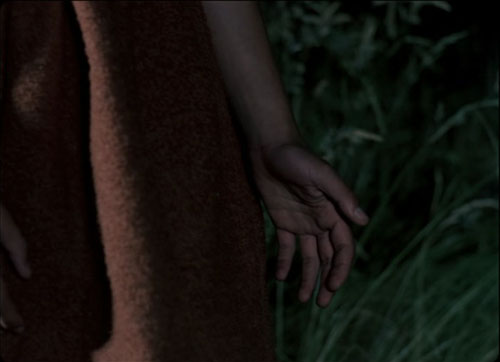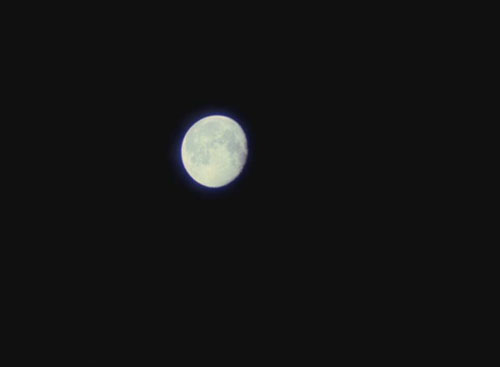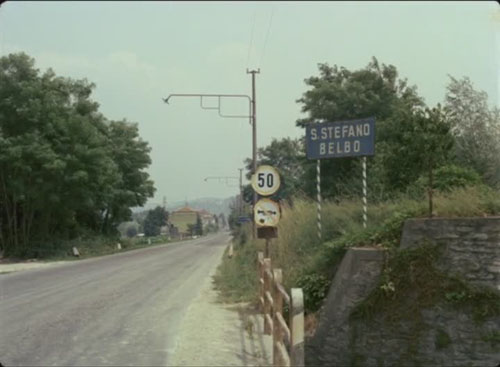
About Dalla Nube alla Resistenza by Straub-Huillet
By Serge Daney
Originally published as ‘Une Morale de la Perception (De la nuée à la résistance de Straub-Huillet)’ in ‘La Rampe. Cahier critique 1970-1982’ (Cahiers du cinéma, Gallimard)
The latest Straubfilm is composed of two separate parts, one mythological, the other modern, without any apparent relation. The Nube part: six of the twenty seven Dialogues with Leuco (‘Dialoghi con Leucò’), written by Cesare Pavese in 1947. The Resistenza part: extracts of another book by Pavese, The Moon and the Bonfires (‘La luna e i falo’), published in 1950, a few months before his suicide. This last part is not a surprise: every Straubfilm is an examination – archeological, geological, ethnographic, military as well – of a situation in which men have resisted. To Nietzsche’s claim that “the only being known to us is being that represents itself”, the straubs would respond: only those who resist exist for sure. Resist nature, language, time, texts, gods, God, chiefs, Nazis. Mother and father. This is how the shot, basic atom of the straubian cinema, is the product, the “reste” (remainder), or rather the “restance” (remaining)* of a triple resistance: texts resisting bodies, places resisting texts, bodies resisting places. One has to add a fourth: the public resisting shots “designed” like that, stubborn resistance of cinema’s public to something intractable, something which renounces it as a public.
I will not come back to this. First of all because the past fifteen years we have written a lot about this in Cahiers. Furthermore because what is striking in the Italian Nicht Versöhnt which is Dalla Nuba is something else: the sensuality, the taste of narration, the joy of language and something like a will to elucidate this “be that as it may, we have to follow through” which almost impels me to say that this film has some elements of a psychoanalysis of the Straubs by themselves. As if, after finishing their Jewish triptych (composed of Einleitung zu Arnold Schönbergs “Begleitmusik zu einer Lichtspielszene, Moses und Aaron and Fortini Cani), after having brandished the signifier “resistance” as an absolute (because, without a doubt, being Jewish means resisting and, most of all, resisting the Book), they pitch into its genealogy. Resistance is the point of arrival of a story that has begun elsewhere, earlier, with the cloud. What is this story that straddles two millennia, entangles men and gods, and then men with the most terrible – and the most modern – of divinities, History? When did resistance begin? Why resist? And what is it one is resisting, exactly?

Against the spectacle. But what spectacle?
The six dialogues constituting the first part of the film recount an unique event: the gods separating from men. All proximity between them has been eclipsed, as well as the alliance, the promiscuity, the intermixture. The new law is announced in the first shot of the film by the nymph Nephele, the cloud, while sitting on a tree. “There are monsters”, she says. From then on those who – like the centaurs – have engaged in a dual nature realize they are monsters and go into hiding. Every dialogue marks a deepening of the separation. I summarize: the gods dissociate themselves from men, abandoning them (second dialogue: the Chimera), they separate men from things by giving them a name (third dialogue: the Blind), they separate them from themselves and transform them into animals (fourth dialogue: the Werewolf), they separate some from others by way of sacrifices (fifth dialogue: The Guests) and the separation is complete when they idly content themselves with watching these sacrifices (sixth dialogue: the Bonfires).
This last dialogue marks, at the same time as being the end of the first part, the beginning of the resistance, if not of the revolt, and prefigures the second part – the “modern” part – by way of the theme of bonfires. It’s worthwhile to linger here for a while. To his father who explains him that these fires have to be lit up, a young peasant answers: “I do not want to, you understand, I do not want to. They do well, the masters, to eat our marrow, if we have been so unjust among ourselves. They do well, the gods, to watch us suffer.” Purposely, Straub leaves out the end of Pavese’s dialogue (‘the son adds: “siamo tutti cattivi” – we are all vicious –and the father treats him like an ignorant before renewing his offering to Zeus). In the same way, he has not kept the first two sentences of the dialogue (Pavese began by making the son say “the whole mountain is burning”), instead starting with the son’s assertion that “Our bonfire, nobody sees it.”
We have spoken too much about the Straub’s meticulous respect for texts to not notice how they violate them here. Because these cuts haven’t been made haphazardly, nor is the fact that the theme of looking is privileged. The resistance begins at the moment when, once their separation from the gods is complete, men imagine themselves as the spectacle in which the gods take pleasure, from afar. Beginning of the resistance and also beginning of the pose, of theater. There is a taste of antique theater – toga and tunic – in Straub’s work that refers to Cecil B. De Mille as well as the situations of Terror it connotes. Beginning of indulgence, of aestheticism, of a “m’as-tu-vu” reserved for the human body. Between the carefreeness of Ixion who doesn’t take what the nymph says very seriously (first dialogue) and the first No! (sixth dialogue: the camera zooms in on the boy’s hand, a hand hesitating to clench itself into a fist), the distance between gods and men, in growing larger, has become the space of aesthetic contemplation. “Son: They are unjust, the gods. Father: If it were not thus, they would not be gods. One who does not work, how do you want him to spend his time? When there were no masters and people lived with justice, one had to kill someone from time to time to let them enjoy themselves. They are made thus. But in our time, they don’t need that any more. There are so many of us in a bad way that it is enough for them to watch us.” So the misfortune of men is one and the same as their transformation in objects of esthetic pleasure for the idle gods. Of course, the gods are also the chiefs, the spectators – all those who don’t work. And resisting them is first of all refusing being looked at. This means, for example, turning your back on them.
Refusal of spectacle, shame on the spectator-god, this spoiled brat. Describing the gods to Ixion, Nephele says: “They feel everything from afar with their eyes, their nostrils, their lips.” The construction of the Straubian shot comes down to a practice of framing that breaks with this distance, teaching us to “look closely”, bending the homogeneous space of paranoiac contemplation with which the gods-spectators dispossess men (actors) of their misfortune and with which men, while trying to please them, change into histrionics of their lot, which has become fate. It’s this refusal of a backdrop, of a background (arrière-plan) that confers on Dalla Nube this immediate, pathetic sensuality, inclining that the memory of a world “where we could be at home”, of a intimacy with things, has to be entrusted to senses that are better placed outside of the body – hearing, touch. Not the look.

True inscription or superimposition?
There is no background (arrière-plan), so be it. But is there all the same a shot (plan)? Or else, what is the content of what is called, by convenience, a shot? Content has to be understood literally here. In a short film entitled Toute Révolution est un coup de dés, the Straubs have the actors say a poem by Mallarmé at the Pere-Lachaise graveyard: the “actors” (each a typographical character) are disseminated – as a lively form of writing – over the slope of a small hill. It’s under this hill that the victims of la Commune are buried. But this is not made explicit in the film. In Fortini Cani, the camera wanders several times through the Italian countryside where, during World War II, civilian populations have been massacred. The content of the shot, stricto sensu, is what it hides: the bodies under the ground. From this we could deduce a sort of necrophiliac piety, conducted by the Straubs against the spectator, summoned to know or to keep quiet in respect for the dead – and those particular dead most of all. Impossible coalescence between the perceived and the known, the content of a perception and the perception of a knowledge. In this sense, the politics (and the morals) of the Straubs is a politics (and a morals) of perception. In this sense, it is materialist, but à la Lucrèce or Diderot. In Dalla Nuba too, the shots have a content. It’s, for example, the wheat-field that the Guest (Herakles) watches and admires (fifth dialogue), although he knows that every year it’s fertilized with the blood of a victim of sacrifice and that he has been chosen to be this victim. It’s the magnificent shot of “the grass and the acacias” in front of which, at the end of the film, Nuto reveals to the bastard that this is the place where Santa was killed, before being burned by the partisans. It’s finally the shot of the werewolf (fourth dialogue) of which the hunters ask what to do because, according to them “It is not the first time that a beast has been killed / But it is the first time that we have killed a man”. These three examples are nevertheless sufficient to instill doubt. Doubt as for what we see. Because what happens in this “passage” from polytheism to monotheism – which interests the Straubs a great deal – if else than that we are less and less able to make out what is metamorphosing? Blood in wheat, man in wolf, woman in fire, etc.
So there are two limits to the Straubian shot. One, internal, is what it contains – the shot as a tomb. The other, unrepresentable, undecidable, is that all things filmed, framed, risk being something else as well. Lycaon, the crying werewolf, wouldn’t be this upset if the hunters wouldn’t refer to him as being a man (“He defended himself as an old man, with his eyes”) and if their embarrassment wouldn’t stem from a more profound doubt, a doubt related to their own identity (“Are you so sure of yourself that you don’t sometimes feel Lycaon like him?”). Sudden risk of being one and the other. In this sense, if we take up the issue of “true inscription” again*, we can say that there is certainly something that inscribes itself materially, indisputably, hic et nunc, in the film and on the magnetic tape, except for we don’t know what it is for sure.
That’s why this idea of resistance is at this point essential for the Straubs. It also has a conjuratory value: resistance is the only indication that doesn’t deceive, that attests to some reality or other, to a node of contradictions. It is, in the Freudian sense, a symptom. Where there is resistance, one has to film. But one doesn’t know what one films and the more one can describe it, the less one knows. In the true inscription, there are only traces of inscription of which we are sure of. The rest is metamorphosis, avatar, double identity and double appertaining, error, betrayal. It’s this suspicion, better: desire to voice this suspicion, that can be perceived for the first time with such exemption in Dalla Nuba.

A shot without image or two images in a shot?
There are tricks the Straubs never use – and even seem to be the negation of their cinema – such as superimposition or cross-fading. Every time an image overlays another (unless one image contains the other), every time an image prefigures another (unless one image is already the other’s memory). The time of superimposition is that of the active work of forgetting: a voice tells us: “you will forget, you have already forgotten”. This infringement of an image on another is one of the two limits of the Straubian shot. The other is the black (or empty) screen. In Moses und Aron there was the bedazzlement of an empty shot, of a non-image. In Dalla nube, there’s something else, there is a disclaimer: whatever you are looking at, a cultivated field, a hill, an animal, don’t forget that what you see is always human. If seeing a film, in the Godard-Miéville version, is about equating dad with the factory and mom with a landscape, in the Straub-Huillet version it’s about equating the factory and – more and more – the landscape with mom and dad. Humanism then, in the sense of a prevalency, of a pregnancy of the human image in all things. It is in this sense that these films “are watching us”: someone is watching us in the depth of each image, in an impossible superimposition. Cinema is what permits to suspend the enchantment which makes us think that we see all around us other than human things, while they are only cultivated fields, cut down trees, unknown cemeteries, animals-who-might-be-human (thus forbidding to kill them). Old Marxist humanism as well, in the sense that Brecht said that a picture of the Krupp factories taught us nothing about the Krupp factories. What is missing? The work of men and men at work. And what is there to learn? Always the same thing: men create gods (or the workers create chiefs, actors create spectators) and in return those gods bereave them of their world, turn them into strangers, alienate them. Because it’s clearly about alienation and re-appropriation, experience and bad experience, an entire existentialist problematic to which Straub’s cinema clings to. All of the sudden we understand their horror for the already-made esthetic categories: finding a shot of a landscape “beautiful” is bordering on blasphemy, because a shot, a landscape, is, in the end, someone. There is no beauty if not moral. It’s not about anthropomorphism. There is pregnancy of the human figure in all things, but not the other way around. If we consider a filmmaker important in so far as one studies, from film to film, a certain state of the human body, then the Straub’s films are but documentaries about two or three body positions: sitting, bending over to read, walking. It’s already a lot.

Humanism or hommanism?
When Fortini Cani came out, Straub declared that his film was a bit like Hawks. This comparison failed to convince anyone and even shocked some. While watching Dalla Nube, I wondered if it shouldn’t be taken seriously. The two filmmakers have something in common: an almost total interest for all that is not the human body: a talking and moving body. A male body. Their humanism is also based on a play of words: is it men (biological species), Men (human essence) or men (human in its male form)? We have talked a lot about the Hawksian misogyny but little about the Straubfilms from the angle of the difference of sexes. Yet it‘s clear that, at least since Geschichtsunterricht, we are in a heroic world, a world of warriors, where women are scarce, up to the point of almost disappearing completely in Dalla Nube. There are no women in the Straubfilms, I mean no figuration of women. No mothers either. Undoubtedly because in the eye of a mother, “humanism”, that is to say heroism without object that her offspring shares with little friends, will always be a bit derisory, touching and not far-reaching. Humanism, as we can see more and more, is an invention of men. It’s, as Lacan says, a “hommanism”, the sympathetic and sublimated version of the alliance of men against women.
Dalla nube alla resistenza opens with the somewhat unreal image of the death of a goddess (the admirable Olimpia Carlisi) and closes with the story of the death of a woman, Santa, whom the partisans had to kill because she, too, had betrayed them. At the beginning of the cloud and the end of the resistance, there is a double play, a double pertaining that has, twofold, a feminine figure. A figure materializing what the Straubfilms explore: betrayal. Because beyond these stories of idle gods and revolting men, it seems to me that Jean-Marie Straub and Danièle Huillet silently speak about something that remains largely unsung (because the solidity of the social bond depends on this ignorance): that there is a profound indifference of women for all belief in an ideal. An indifference dryly contrasting with the somewhat melodramatic piety of which the relations between men are made up (see the pathos in the father-son saga of Fortini Cani, or, in Dalla nube, the friendship between the bastard and Cinto, the little boy with the knife). Here’s what resists against humanism and what hommanism feeds off: women. Resisting those who are resisting, men. Women, stones. Because “the stone is not touched with words” (third dialogue). Stones: indestructible elements that Straub, not at all pantheist, avoids calling nature. “The things of the world are stone”, says the blind Tiresias – who was a woman for seven years – to a blind man to be – whose name is Oedipus.
——————————————————————————————————————————————————————-
Translated by Stoffel Debuysere (Please contact me if you can improve the translation).
In the context of the research project “Figures of Dissent (Cinema of Politics, Politics of Cinema)”
KASK / School of Arts
translator’s notes
* The translation of six dialogues by Cesare Pavese for English subtitled prints of Dalla nube alla resistenza can be found on Lumen.
* The ideas of “reste” (remainder) and “restance” (remaining) stem from Jacques Derrida. In ‘Others Are Secret Because They Are Other’ (“Autrui est secret parce qu’il est autre”) he wrote: “A trace is never present, fully present, by definition; it inscribes in itself the reference to the specter of something else. The remainder is not present either, any more than a trace as such. And that is why I have been much taken up with the question of the remainder, often under this very name or more rigorously under that of resistance or remaining. The remaining of the remainder is not reducible to an actual residue, or to what is left after a subtraction, either. The remainder is not, it is not a being, not a modification of that which is. Like the trace, the remaining offers itself for thought before or beyond being. It is inaccessible to a straightforward intuitive perception (since it refers to something wholly other, it inscribes in itself something of the infinitely other), and it escapes all forms of prehension, all forms of monumentalization, and all forms of archivation. Often, like the trace, I associate it with ashes: remains without a substantial remainder, essentially, but which have to be taken account of and without which there would be neither accounting nor calculation, nor a principle of reason able to give an account or a rationale {reddere rationem), nor a being as such. That is why there are remainder effects, in the sense of a result or a present, idealizable, ideally iterable residue. What we are saying at the moment is not reducible to the notes you are taking, the recording we are making, or the words I am uttering—to what will remain of it in the world. The remains of what remains cannot be calculated in this way. But there will also be remainder effects, sentences fixed on paper, more or less readable and reproducible. These remainder effects will thereby have presence effects—differently in one place or another, and in an extremely un- even way according to the contexts and the subjects that will get attached to it. A dispersion of the remainder effects, different interpretations, but nowhere the substance of a remainder that is present and identical with itself.” (published in Paper Machine (2005). trans. Rachel Bowlby)
* Inscription vraie: “true inscription” (or “inscription of truth”) refers to the photographic trace of the world as a bearer of truth. On the subject, see texts by Pascal Bonitzer (‘J.M.S et J.L.G.’, Cahiers 264) and Jean Narboni (Fortini/Cani, Cahiers 275). Bonitzer wrote: “Something striking in the work of Straub is at which point he is concerned with true inscription. Moreover, we are aware of everything that a clever and modern criticism could reveal in regards to “metaphysics” in this issue of truth. But it’s more interesting to explore how this truth is produced, how it is thought, and what it subverts of the visible field, of the cinematographic specter.”